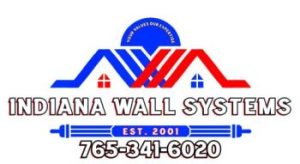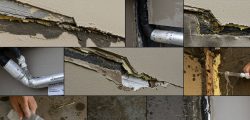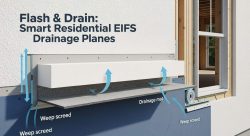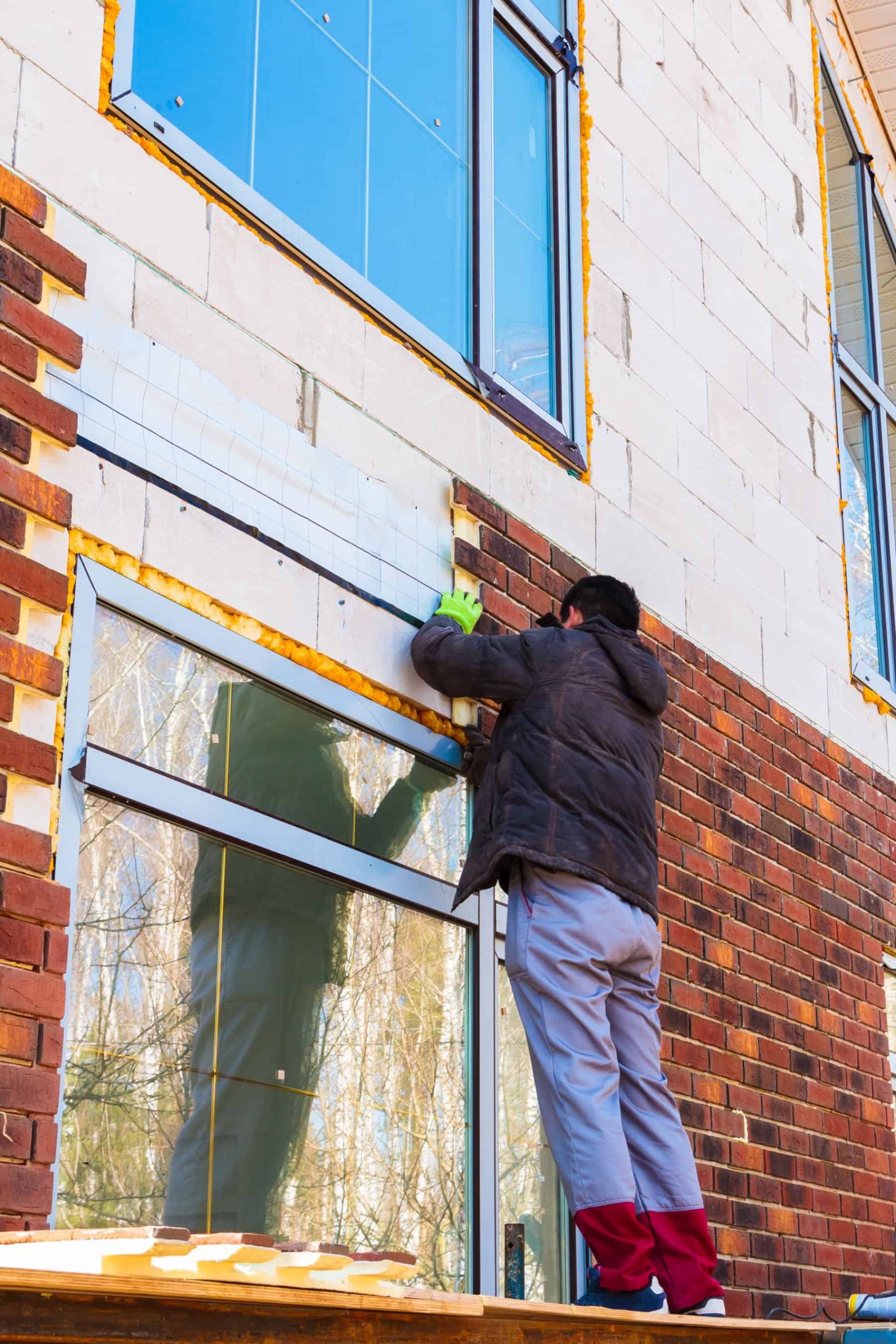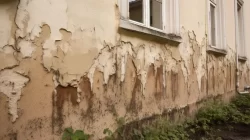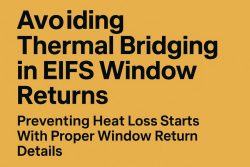Expert Tips and Step-By-Step Guide for Homeowners Looking to Upgrade Their Exterior Insulation System While Avoiding Costly Structural Damage
Is your EIFS showing cracks, water damage, or just looking worn out? Old exterior insulation and finish systems need proper care when being removed to avoid costly damage to your home.
Drainable EIFS systems are among the most effective options for preventing water damage during replacement. This guide will walk you through the safe removal and replacement process step by step.
Your home deserves the best protection.
Key Takeaways
- Check your EIFS twice yearly for cracks, water damage, or worn spots to catch problems early.
- Drainable EIFS systems prevent water damage better than older face-sealed types.
- Proper removal starts with cutting clean edges, then using a pry bar to lift EIFS from top to bottom.
- New EIFS costs between $7-15 per square foot, so budget an extra 10-15% for hidden problems.
- Quality materials may cost more upfront but need less care and last longer, saving money over time.
Understanding EIFS and Its Purpose
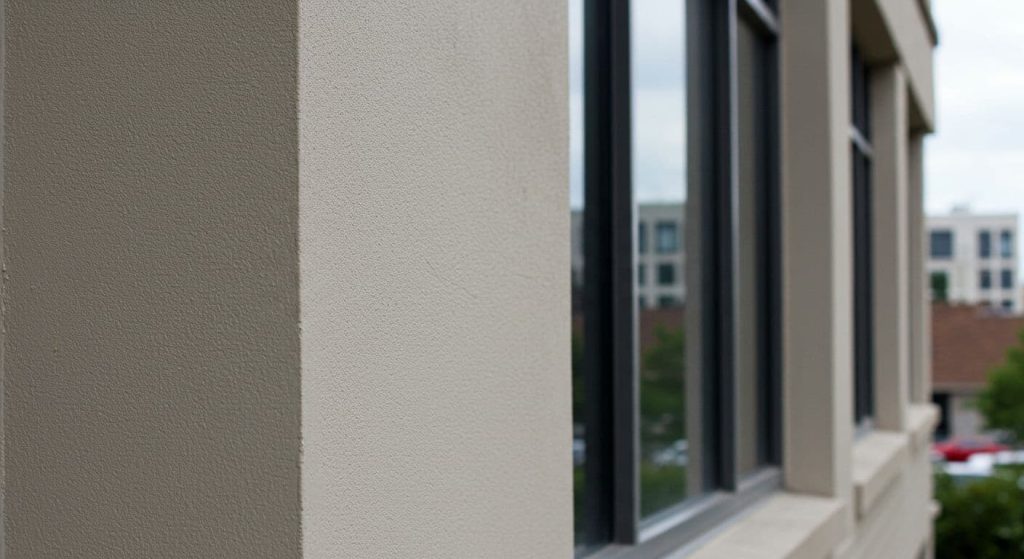
EIFS systems offer a shield against weather while keeping your home warm in winter and cool in summer. These exterior wall coverings combine insulation and finish coats to create an energy-smart barrier that can last for decades with proper care.
What is EIFS?
EIFS stands for Exterior Insulation and Finish System. This siding option works as a synthetic stucco that covers your home’s outside walls. EIFS has layers – insulation boards attach to your wall, then mesh and base coats go on top, with a final finish coat for looks.
Many homeowners pick EIFS for its energy-saving benefits and smooth, clean look.
EIFS comes in two main types: barrier systems and drainable systems. Drainable EIFS works best at stopping water damage and doesn’t have the same limits as older face-sealed types.
The system helps cut energy costs by wrapping your home in a blanket of insulation. Glued EIFS is the easiest type to remove if you ever need to replace it. Most pros suggest checking your EIFS twice yearly for cracks or damage.
Energy-efficient and water-resistant properties
EIFS offers top-notch energy savings for your home. The system works like a blanket, keeping heat inside during winter and outside during summer. This cuts down your energy bills year-round.
Most EIFS includes foam insulation boards that stop thermal bridging – where heat escapes through walls. Drainable EIFS systems are even better at keeping water out than older types.
These systems create a strong barrier against rain and moisture. The outer layer repels water while still letting the wall breathe. Modern EIFS includes special drainage planes that channel any water that gets behind the surface safely away from your home.
This helps prevent mold growth and structural damage. Regular checks of your EIFS finish and sealants twice yearly will help spot issues before they cause problems. Next, let’s look at the common issues that pop up with older EIFS installations.
Common issues with older EIFS
Older EIFS systems often face serious water damage problems due to poor design. Cracks and gaps around windows and doors let moisture seep behind the surface, rotting the wood underneath.
Many homes built before 2000 have face-sealed systems without proper drainage paths, making them more likely to trap water. This trapped moisture leads to mold growth, wood rot, and even structural damage if not fixed quickly.
Failing sealants also plague aging EIFS installations, needing replacement every 8-10 years. Many homeowners miss these maintenance needs until damage has spread. Impact damage is another common issue – even small holes from hail or accidents can let water in.
Regular checks twice yearly can catch these problems early, saving you from costly full replacement that can run thousands of dollars per wall section.
When to Consider Removing and Replacing EIFS
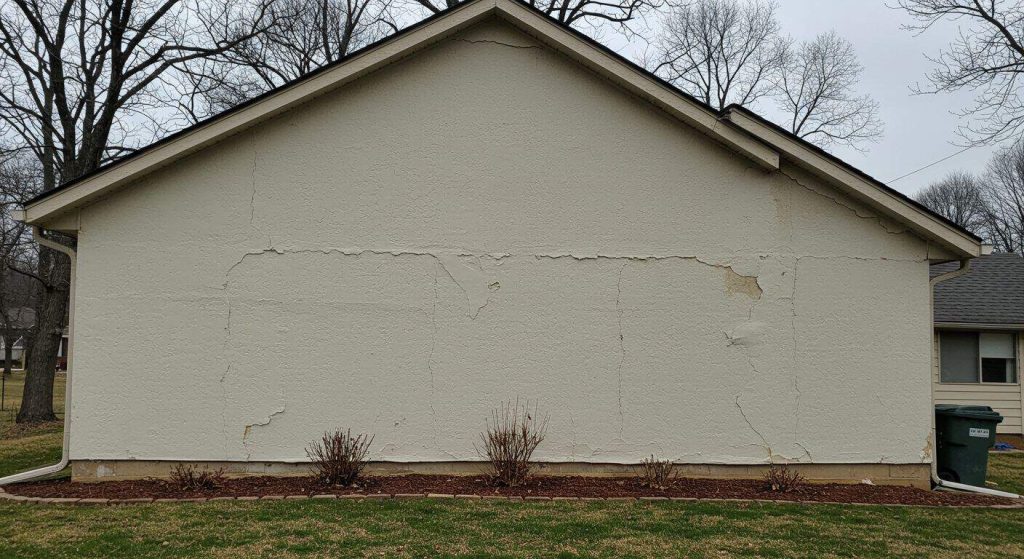
Your EIFS needs replacement when repairs no longer fix the problems. Walls with major water damage, large cracks, or outdated looks are clear signs it’s time for a full system overhaul.
Signs of extensive water damage
Dark stains on your EIFS walls often signal big trouble beneath the surface. These spots might appear near windows, doors, or along the bottom of walls where water collects. Look for bubbling or peeling in the finish coat – this happens when moisture gets trapped behind the system.
Soft spots in your EIFS are major red flags that need quick action. If you press on the wall and it feels mushy rather than firm, water has likely damaged the substrate underneath.
Mold growth, both inside and outside your home, points to serious moisture problems in your EIFS. You might notice a musty smell before you see any visible signs. Drainable EIFS systems help prevent these issues, but older face-sealed systems are more prone to water damage.
Experts recommend inspecting your EIFS twice yearly to catch these problems early. Regular checks can save you from the high costs of full removal and replacement, which becomes necessary when water damage spreads throughout the system.
Persistent cracking despite repairs
Beyond water damage, cracks that keep coming back after fixes are a clear sign your EIFS needs replacement. Small cracks might start as tiny lines but grow larger over time. Even with proper patch jobs, these stubborn cracks often return because of deeper issues in the system.
If you’ve fixed the same spots multiple times within a few years, it’s time for a full EIFS replacement. The mesh reinforcement or substrate underneath may have failed. Drainable EIFS systems offer better solutions than older face-sealed types.
They prevent moisture problems that cause these endless crack cycles. Experts suggest checking your EIFS twice yearly to catch these issues early. Regular checks can save you money before small cracks turn into major problems that affect your home’s structural integrity.
Need for improved durability and aesthetics
Old EIFS often needs replacement to boost both looks and toughness. Homes with worn-out exteriors can lose value fast, while fresh EIFS adds curb appeal right away. Drainable EIFS systems offer much better protection against water damage than older face-sealed types.
These modern systems prevent moisture issues that plague many homes with aging exteriors.
Your home deserves strong protection that also looks great. Newer EIFS materials provide better impact resistance and weather protection while lasting longer. Many homeowners choose to upgrade when they notice fading colors or persistent cracking that won’t go away with simple repairs.
A full replacement lets you pick from today’s improved finish materials that need less upkeep – only requiring cleaning every five years instead of constant touch-ups.
Proper Preparation for EIFS Removal
Before you start ripping off old EIFS, proper prep work saves time, money, and headaches down the road – from checking moisture levels to picking the right tools for your specific wall system.
Conducting a full inspection
A proper EIFS inspection starts with a close look at all surfaces. You need to check for cracks, bulges, and spots where water might get in. Inspect all sealants around windows and doors since these often fail first.
Look for signs of moisture damage like stains or soft spots. Twice-yearly checks help catch small issues before they grow into big problems.
Tools like moisture meters can find hidden water damage behind your EIFS. Your inspector should test areas around windows, doors, and roof lines where leaks often start. Drainable EIFS systems have fewer problems than older face-sealed types.
A good inspection report will show all trouble spots and guide your next steps for repair or full replacement.
Assessing the extent of damage
Before starting any EIFS removal, you need to know how bad the damage really is. A full check of your walls can show if water has gotten behind the EIFS system. Look for soft spots, cracks, or areas where the finish has come loose.
Moisture testing tools help find hidden water damage that your eyes can’t see. Most pros check twice a year for signs of trouble, as catching problems early saves money.
The damage might go deeper than what shows on the surface. Glued EIFS is easier to take off than other types, which helps during removal. Your contractor should check all flashing details, weatherproofing, and expansion joints too.
If you see damage around windows or doors, it often means water has been leaking in for some time. Fixing these spots is key to stopping more harm to your home’s structure.
Determining the right tools and techniques
Picking the right tools makes EIFS removal faster and safer. You’ll need a utility knife, pry bar, and hammer for basic removal work. Specialized sealant removal tools like razor knives help clear out old, failing caulk without damaging the surface beneath.
For larger jobs, power tools such as reciprocating saws speed up the process but must be used with care to avoid hitting the substrate.
Your removal plan should match your EIFS type. Glued EIFS comes off more easily than other types, making it simpler to replace. Always wear safety gear – gloves, goggles, and dust masks protect you from sharp edges and harmful particles.
Having a moisture meter on hand helps spot hidden water damage that might need fixing before new EIFS goes up.
Safe Techniques for Removing Old EIFS
Removing old EIFS takes skill and care to avoid damaging the structure underneath. Our step-by-step guide shows you how to safely take off each layer while keeping your home’s frame intact.
Step-by-step removal process
First, mark all areas that need removal with bright tape. Cut around these sections with a utility knife to create clean edges. Next, use a pry bar to lift the EIFS from the wall surface, working from top to bottom.
Glued EIFS comes off more easily than other types, making your job simpler. Remove all layers including finish coat, base coat, mesh, and foam board. Clear away old sealants with a razor knife or sealant cutout tool.
Put all waste in heavy-duty bags for proper disposal.
After removal, check the wall for damage. Look for wet spots, rot, or mold that may have formed from water getting behind the EIFS. Fix these issues before moving forward. This step matters most since hidden damage causes bigger problems later.
Now you’re ready to prepare the surface for your new system installation.
Avoiding damage to the substrate
Removing EIFS without harming the substrate takes care and the right tools. Most pros use special tools like razor knives to cut away old sealant first. This step helps protect the surface under the EIFS from tears or cracks.
Glued EIFS is actually easier to remove than other types, making your job simpler. During removal, work in small sections and pull the material away at a slight angle rather than straight out.
Watch for signs of water damage on the substrate as you remove each piece. Drainable EIFS systems cause less damage to substrates than face-sealed types. If you find wet or soft spots, let these areas dry fully before moving forward.
Clean all adhesive from the surface using gentle scrapers – not power tools that might gouge the material. This careful approach saves time and money by avoiding the need to replace damaged substrate materials.
Handling debris and waste disposal
EIFS removal creates lots of waste that needs proper handling. You’ll need to rent a dumpster or large trash containers for the foam boards, mesh, and old stucco pieces. Most EIFS debris isn’t hazardous, but check local rules before disposal.
Some areas have special rules for construction waste. Cover nearby plants and property with tarps during removal to catch falling pieces and make cleanup easier.
Proper cleanup saves time and prevents problems later. Use specialized tools like razor knives to remove all old sealant completely. Bag smaller pieces right away to stop them from blowing around your yard.
This step matters because leftover debris can damage your lawn mower or hurt pets. After the job, a final site cleanup ensures no sharp pieces remain that could cause injuries or puncture tires.
Installing a New EIFS System
Installing a new EIFS system needs careful planning and proper steps to ensure lasting results. A fresh EIFS setup gives your home better protection against weather while adding a clean, modern look to your property.
Preparing the surface for new installation
Getting your walls ready for new EIFS needs careful work. First, remove all old material down to the sheathing. Check this base layer for rot or damage – replace any bad sections right away.
Clean the surface with a low-pressure wash to remove dirt and debris. This cleaning step is vital since any leftover grime can stop the new system from sticking properly. The surface must be completely dry before moving forward.
Next, apply a quality moisture barrier to protect against water intrusion. This step is crucial since water damage is the main enemy of EIFS systems. Make sure all seams overlap correctly and seal around windows, doors, and other openings.
Proper substrate preparation now saves huge headaches later. Many pros use drainable EIFS systems which offer better protection than older face-sealed types. These modern systems include drainage paths that let any trapped moisture escape safely.
Applying water barriers and insulation boards
After preparing the surface, you’ll need to add water barriers and insulation boards to create a strong foundation for your new EIFS system. Water barriers act as your home’s shield against moisture damage.
These barriers must cover the entire wall surface with proper overlaps at all joints. The right barrier can prevent the moisture issues that plague many older EIFS installations. Drainable EIFS systems are most effective at stopping water damage, making them worth the extra cost for long-term protection.
Next comes the insulation board installation – a key step for energy efficiency. Boards must be attached firmly using the proper adhesive or mechanical fasteners. Gaps between boards should be minimal and filled with foam sealant, not base coat material.
Proper board installation creates a flat, even surface for the next layers. Many property owners find that upgrading to newer insulation materials during replacement leads to lower energy bills and better home comfort.
The boards should be checked for level and adjusted before moving forward with the mesh layer.
Installing reinforced mesh and base coat
Reinforced mesh gives your EIFS system strength and crack resistance. Pros apply this mesh directly to the insulation boards, pressing it firmly into a wet base coat. The mesh must overlap at seams by at least 2.5 inches to create a strong, continuous layer.
This step is crucial for making your EIFS last longer – proper mesh installation helps prevent those small cracks that can lead to water damage.
The base coat needs to fully cover the mesh while still allowing its pattern to show through. Most EIFS contractors use a trowel to spread this material evenly at about 1/16 inch thick.
This layer must dry completely before adding the finish coat – usually 24 hours in good weather. Drainable EIFS systems, which are better at stopping water damage, need extra care during this step to maintain their drainage channels.
Adding the finish coat for protection and aesthetics
The finish coat is the final layer that makes your EIFS look great while keeping it safe. This top coat needs careful application with the right tools to create a smooth, even surface.
Most pros use acrylic coatings that resist water and last for years. You can pick from many colors and textures to match your home’s style. The finish coat must be at least 1/16-inch thick to work properly.
Your new finish coat does more than look pretty – it shields your home from rain, sun, and dirt. A quality finish coat can last 8-10 years before needing attention. Drainable EIFS systems with good finish coats prevent water damage better than older systems.
For best results, make sure your contractor uses premium materials and follows proper application steps. This final layer gives your home both curb appeal and vital protection against the elements.
Factors to Consider During Replacement
Replacing your EIFS system requires careful planning to avoid budget surprises and future headaches. Smart homeowners compare material costs and durability ratings before making their final choice.
Cost and budget planning
Planning your EIFS replacement budget starts with getting quotes from at least three experienced contractors. Most EIFS projects cost between $7-15 per square foot, depending on your home’s size and damage extent.
Don’t forget to add 10-15% extra for hidden problems that often pop up during removal. Your budget should cover removal, waste disposal, fixing any damaged areas, and the new EIFS installation.
Many homeowners save money by timing their project during off-peak seasons when contractors offer better rates.
Your budget must include high-quality materials since cutting corners now leads to more costs later. Drainable EIFS systems cost more upfront but prevent water damage and last longer than older systems.
The right sealants and proper caulking techniques add to your initial cost but reduce repair needs down the road. Smart homeowners plan their EIFS replacement as part of a larger renovation to save on labor costs and create a more energy-efficient home that pays back through lower heating and cooling bills.
Choosing durable and low-maintenance materials
After setting your budget, focus on picking materials that last and need little care. Modern EIFS systems offer better options than older versions. Drainable EIFS ranks among the most effective choices for stopping water damage.
These systems don’t have the same limits as face-sealed or barrier systems. Look for products with high vapor permeability to let moisture escape and prevent rot.
Materials matter most for your home’s long-term health. Quality sealants need replacement only every 8-10 years, saving you money over time. Some homeowners pick the “Sonneborn System” as a stucco option instead of traditional EIFS.
This choice gives you both durability and style. Good materials also help with thermal insulation, cutting your energy bills while making your home more comfortable.
Ensuring compliance with building codes
Building codes exist to keep your home safe and sound. Your new EIFS system must meet local rules about fire safety, energy use, and water protection. Most areas need permits before you start work.
Local codes may set rules for how thick your insulation must be or what kind of drainage system you need. Drainable EIFS systems often pass code checks more easily than older face-sealed types because they handle water better.
You need a pro who knows these rules inside and out. Good contractors pull all needed permits and schedule required inspections. They follow the right steps for your area’s weather needs.
This helps avoid fines and future problems with your home sale. The right EIFS pro will make sure your new system meets or beats all building envelope standards, giving you true peace of mind.
Benefits of Upgrading or Replacing EIFS
Upgrading your old EIFS system adds major value to your home while cutting energy costs. New EIFS materials offer better weather defense and can boost your property’s curb appeal with fresh, modern looks.
Enhanced durability and weather resistance
New EIFS systems offer much better protection against harsh weather than older versions. Modern materials stand up to rain, wind, and sun damage for years longer than their predecessors.
Drainable EIFS ranks among the most effective options for stopping water damage – a huge upgrade from face-sealed systems. These newer systems include improved weather-resistant barriers that keep moisture from getting behind your walls.
The advanced sealants used today last 8-10 years before needing replacement, compared to the shorter lifespan of older products.
Your home faces tough conditions year after year. Upgrading to current EIFS technology means fewer cracks, less peeling, and reduced risk of delamination. The latest systems include better control joints that allow for building movement without damage.
Many homeowners see these improvements translate to lower repair costs over time. Regular maintenance becomes simpler too – a low-pressure wash every 3-5 years keeps your exterior looking fresh while preserving its protective qualities.
Improved energy efficiency
New EIFS systems offer much better insulation than older versions. Modern EIFS can cut your heating and cooling costs by creating a tight thermal barrier around your home. This happens because the foam insulation boards in today’s systems are more effective at stopping heat transfer.
Your home stays cooler in summer and warmer in winter, which means your HVAC system works less. Many homeowners report lower utility bills after upgrading to newer EIFS materials.
Drainable EIFS options add more value to your home’s energy performance. These systems keep moisture out and maintain their insulating properties longer. The advanced materials used in current EIFS installations can last 8-10 years before needing sealant work, making them a smart investment for your home.
The right contractor can help you select EIFS materials that match your climate needs and budget goals. Upgrading your EIFS can boost your property’s value and curb appeal.
Increased property value and curb appeal
New EIFS gives your home a fresh look that stands out in the neighborhood. Fresh cladding boosts your home’s value by up to 10% in many markets. The clean lines and smooth finish of modern EIFS systems create strong street appeal that draws positive attention.
Buyers notice homes with well-maintained exteriors first, making your property more marketable if you decide to sell.
Upgrading to drainable EIFS systems adds both beauty and function to your home. These systems rank among the most effective at stopping water damage while looking great. The right finish coat offers endless color options to match your style preferences.
Many homeowners find that EIFS replacement pays for itself through energy savings and higher resale values. Regular cleaning every five years keeps your investment looking its best for decades.
Choosing the Right Contractor for EIFS Replacement
Picking a skilled EIFS contractor with proper licenses and insurance can save you from costly mistakes and ensure your home gets the quality work it deserves – read on to learn what makes a great EIFS pro and how to spot red flags before signing any contracts.
Importance of experience and expertise
Hiring pros with EIFS know-how makes all the difference in your home project. Expert contractors can spot issues like adhesive failure that untrained eyes miss during the twice-yearly checks your EIFS needs.
They bring the right tools for the job – from sealant cutout tools to proper power washing gear that won’t damage your walls. These skilled workers follow strict safety rules and know how to handle debris removal without harming your property.
Their deep grasp of building science means they can fix hidden moisture problems that might lurk behind your walls.
The cost of fixing EIFS mistakes far outweighs paying for skill upfront. Pros who work with EIFS daily understand that drainable systems work better than face-sealed ones at stopping water damage.
They can tell you if the Sonneborn System might work better for your home than standard EIFS. Good contractors also keep up with building codes and new materials that last longer in your climate.
Your choice of contractor will directly impact how well your new EIFS stands up to time and weather, making proper licensing and insurance the next critical factor to check.
Checking references and reputation
Always ask EIFS contractors for past client references. Good contractors will gladly share contact info from happy customers. Call these references to ask about work quality, cleanup habits, and if the job finished on time.
Check online reviews too – sites like Google, Yelp, and the Better Business Bureau show what others think. A trustworthy EIFS pro should have proper certification and at least five years of experience with stucco systems.
Look for contractors who know how to install drainable EIFS, which stops water damage better than older systems. The right pro will talk about twice-yearly inspections and proper cleaning every five years.
They’ll explain how glued EIFS comes off easier during replacement work. Good reputation comes from proper installation skills and following building codes – not just from low prices.
Ensuring proper licensing and insurance
Never hire an EIFS contractor without checking their papers first. A licensed contractor must show proof of both general liability and workers’ compensation insurance. This protects your home if damage happens during the project or if a worker gets hurt on your property.
Ask to see their EIFS certification too – proper training means they know how to install drainable systems that prevent water damage. Good contractors will gladly share these documents with you.
Many states require specific licenses for exterior work, so verify your contractor meets local rules before signing anything.
Call your local building department to confirm the contractor’s license status. You can also contact their insurance company directly to make sure their policy is active. Proper paperwork might cost you more upfront, but saves thousands in potential damages later.
Experienced EIFS pros with proper credentials understand how to handle the renovation process safely while following environmental compliance standards. This small step helps avoid costly mistakes during your exterior renovation project.
Maintenance Tips for Your New EIFS System
Your new EIFS system needs regular care to stay in top shape for years to come. Simple steps like checking for cracks and fixing small issues right away can stop water damage and save you money on major repairs.
Regular inspections for cracks and damage
Check your EIFS walls at least twice a year for signs of trouble. Look for cracks, chips, or spots where the finish seems loose or damaged. These small issues can let water sneak behind your walls if left alone.
Grab a flashlight and scan areas around windows, doors, and where different materials meet – these spots often crack first. Pay extra attention after storms or extreme weather changes, as these can stress your EIFS system.
Catching problems early saves money and prevents bigger headaches. A small crack today might mean major water damage tomorrow if ignored. Take photos of any issues you find to track changes over time.
This helps you decide if a problem is getting worse and needs professional help. Next, we’ll discuss how re-caulking seals plays a crucial role in keeping moisture out of your EIFS system.
Re-caulking seals to prevent moisture intrusion
After finding cracks during your regular checks, focus on fixing the seals around your EIFS. Old sealants break down over time and create paths for water to sneak in. You’ll need to remove failing sealant with a razor knife or special cutout tool before applying new material.
This job needs to happen every 8-10 years to keep your home safe from moisture damage.
Fresh sealant acts as your first defense against water problems. Apply it around windows, doors, and any spots where different materials meet. The right caulk creates a tight seal that stops rain from getting behind your EIFS panels.
Make sure to use products made for exterior use that can handle weather changes without cracking. Proper sealing now saves you from costly repairs later.
Cleaning and recoating as needed
Just like seals need fresh caulk, your EIFS surface needs regular cleaning and occasional recoating. Experts suggest a thorough cleaning every five years, but you might need it more often in damp areas where mold likes to grow.
A gentle low-pressure power wash removes dirt and debris that can trap moisture against your walls. This simple step, done every 3-5 years, helps your EIFS last longer and look better.
For older EIFS that shows signs of wear, recoating might be needed. Apply a primer first, then add a fresh finish coat to restore the look and protection of your home’s exterior. This step costs less than full replacement and can extend your siding’s life by years.
Many homeowners find that recoating also gives them a chance to update their home’s color without the mess and expense of total EIFS removal.
Modern Solutions for EIFS Systems
Today’s EIFS systems use better materials that last longer in harsh weather. New coatings can stop water damage before it starts and help your home stay warmer in winter.
Advanced sealants and coatings
Modern EIFS systems now use much better sealants that last longer than older types. These new products stick better to surfaces and can stretch without cracking. Many top-grade sealants now stay good for 15-20 years, unlike the old ones that needed changing every 8-10 years.
They also block water better, which helps stop damage behind your EIFS walls.
New coatings for EIFS offer extra protection against mold and dirt. Some even have special features that help them clean themselves when it rains. These coatings come in more colors and textures than before, giving your home a fresh look while adding years to your EIFS system.
For the best results, make sure you hire pros who know how to apply these products right the first time.
Improved insulation technologies
While advanced sealants create a strong barrier against water, new insulation tech takes your home’s energy savings to the next level. Today’s EIFS systems use foam boards that trap heat better than older versions.
These modern materials can cut your heating bills by keeping warm air inside during winter months.
Drainable EIFS now features special channels that let water escape if it gets behind your walls. This smart design prevents the moisture damage that plagued older systems. Unlike face-sealed barriers, these new systems work well in all climates and need less upkeep.
Many homeowners find they only need to check for damage twice yearly and clean their EIFS every five years to maintain peak performance.
Enhanced durability with modern materials
Today’s EIFS systems offer much better protection than older versions. New materials resist water damage and last longer without cracking. Drainable EIFS systems are top performers for keeping water out of your walls.
These systems include better sealants that don’t fail as quickly as older products did. Modern EIFS can now stand up to weather for 8-10 years before needing new perimeter caulking.
The latest EIFS products use stronger mesh and base coats that don’t break down from sun exposure. Improved finish coats resist dirt and mold growth, cutting down how often you need to clean your walls.
These upgrades mean less money spent on repairs and more time between major maintenance tasks. Your next step is finding the right contractor who knows how to install these advanced systems correctly.
Conclusion
A safe EIFS removal and replacement needs careful planning, the right tools, and skilled workers to avoid damage and ensure lasting results. Learn more about how to protect your home during this important project.
Safety Tips for EIFS Installation and Repair
Always wear proper safety gear when working with EIFS materials. Gloves, eye protection, and dust masks protect you from harmful chemicals and particles. Keep your work area clean to prevent trips and falls.
Specialized tools like razor knives and sealant cutout tools make the job safer and more precise. Never rush the process – careful work prevents damage to the wall structure beneath.
Check weather forecasts before starting any EIFS project. Extreme heat, cold, or rain can affect how materials cure and bond. Inspect your EIFS twice yearly for cracks or damage, and clean surfaces every five years to prevent mold growth.
Low-pressure washing works best for removing debris without causing harm. For areas prone to damage, like around windows and doors, consider complete removal and replacement rather than simple repairs.
This approach fixes underlying problems that might cause future issues.
Recognizing the Time to Replace Your EIFS Instead of Repairing It
Your EIFS system needs full replacement rather than simple fixes in key cases. Check for wide cracks that keep coming back after repairs – this points to deeper issues. Water damage signs like soft spots, mold, or rotting sheathe mean it’s time for a total EIFS replacement.
Most experts say if more than 25% of your EIFS shows damage or if your system is over 20 years old with failing sealants, replacement makes more sense than patching. Glued EIFS is the easiest type to remove, making replacement less costly than you might think.
The cost of frequent repairs adds up fast. If you’re spending money on EIFS fixes every few years, a new system will save you money over time. A full EIFS removal gives you the chance to fix hidden problems like damaged flashing or water barriers.
This step is vital since these issues cause most EIFS failures. Your next step is to learn about modern EIFS solutions that offer better protection against the elements.
Avoiding Common EIFS Repair Mistakes
Many homeowners make costly errors when fixing their EIFS siding. Skipping proper sealant removal ranks high on this list. Always use the right tools – a razor knife or sealant cutout tool – to clear old, failing caulk completely.
Rushing this step leads to poor adhesion and future leaks. Experts suggest replacing perimeter caulking every 8-10 years and washing debris away every 3-5 years to stop problems before they start.
Ignoring regular checks causes small issues to grow into big repairs. Inspect your EIFS twice yearly for cracks or wear. Clean surfaces thoroughly every five years to prevent fungal growth.
For areas with extensive damage, full removal might be smarter than patches. Glued EIFS comes off easier than other types, making replacement less painful. During any work, address hidden problems like damaged flashing to avoid repeat failures down the road.
FAQs
How do I know if my EIFS needs repair or replacement?
Look for issues like cracking, wear and tear, or signs of water damage. An EIFS inspector can check for deterioration at termination points and vulnerable EIFS components. If you see damage to your EIFS or suspect moisture behind the cladding, it’s time to call Indiana Wall Systems or other EIFS pros to handle an assessment.
What are the best EIFS alternatives to consider?
The top EIFS replacement options include traditional stucco, fiber cement siding, and conventional stucco. Each has different benefits in terms of cost savings, material durability, and aesthetic appeal. Your choice should match your renovation budget and the architectural details of your building.
What safety protocols should be followed during EIFS removal?
Proper demolition techniques are crucial for safety. Workers need protective gear, and the area must be contained to prevent debris spread. A structural assessment before work starts helps avoid unexpected issues. Project planning should include clear safety guidelines for all workers removing the EIFS.
How can I prevent water intrusion when installing new cladding?
Use proper backer rod and quality EIFS sealants at all joints. Make sure drip edges are correctly installed. Primer application must be complete before new materials go up. These steps help stop water from getting way behind the EIFS and causing expensive damage later.
What factors affect the cost of EIFS remediation?
The EIFS removal investment depends on several things: how much area is clad in EIFS, the extent of existing damage, project timeline requirements, and whether moisture remediation is needed. Get detailed cost estimation from certified contractors who understand EIFS remediation.
How important is proper installation and maintenance for new EIFS?
Very! Proper installation and maintenance can extend the life of your new system by many years. Following installation guidelines prevents common issues that plague older systems. Regular inspections of EIFS to ensure sealants remain intact will save money long-term. Remember that EIFS weighs less than some alternatives, which affects how it’s attached to your building.
